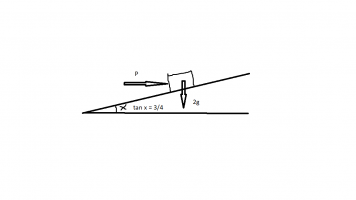James10492
Junior Member
- Joined
- May 17, 2020
- Messages
- 50
Ok now here is another one:

A box of mass 2kg sits in limiting equilibrium on a rough plane angled at x degrees above the horizontal where tan x = 3/4.
A horizontal force of P newtons acting into the plane is applied to the box. Given that the box remains in limiting equilibrium find the maximum possible value of P. (In the problem the hint is given that you should first attempt to work out the coefficient of friction between the box and the plane).
tan x = 3/4, so sin x = 3/5 and cos x = 4/5
let the coefficient of friction = m
Now Friction (F) = m x ( (2g x 4/5) + (P x 3/5) ) = m(8g/5 + 3P/5)
If the box is on the point of moving up the plane,
4P/5 = F + (2g* 3/5)
4P/5 = F + 6g/5
If the box is on the point of moving down the plane then
4P/5 + F = 6g/5
Now I am stuck because I do not see how you can work out m from the resulting expressions.

A box of mass 2kg sits in limiting equilibrium on a rough plane angled at x degrees above the horizontal where tan x = 3/4.
A horizontal force of P newtons acting into the plane is applied to the box. Given that the box remains in limiting equilibrium find the maximum possible value of P. (In the problem the hint is given that you should first attempt to work out the coefficient of friction between the box and the plane).
tan x = 3/4, so sin x = 3/5 and cos x = 4/5
let the coefficient of friction = m
Now Friction (F) = m x ( (2g x 4/5) + (P x 3/5) ) = m(8g/5 + 3P/5)
If the box is on the point of moving up the plane,
4P/5 = F + (2g* 3/5)
4P/5 = F + 6g/5
If the box is on the point of moving down the plane then
4P/5 + F = 6g/5
Now I am stuck because I do not see how you can work out m from the resulting expressions.
